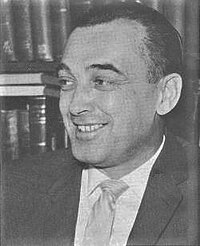Alfred Elton van Vogt
| A. E. van Vogt | |
|---|---|

Van Vogt about 1963
|
|
| Born | Alfred Elton van Vogt April 26, 1912 Gretna, Manitoba, Canada |
| Died | January 26, 2000 (aged 87) Los Angeles, California, US |
| Occupation | Writer |
| Nationality | Canadian |
| Period | 1939–1986 (science fiction) |
| Genre | Science fiction |
| Literary movement | Golden Age of Science Fiction |
| Spouse |
|
|
|
|
| Signature | |
Alfred Elton van Vogt (/væn voʊt/; April 26, 1912 – January 26, 2000) was a Canadian-born science fiction author regarded as one of the most popular, influential and complex practitioners of the mid-twentieth century, the genre's so-called Golden Age.
Van Vogt was born on a farm in Edenburg (a Russian Mennonite community east of Gretna, Manitoba, Canada). Until age four, van Vogt and his family spoke only a dialect of Low German at home. Van Vogt's father, a lawyer, moved his family several times. His son found these moves difficult, remarking in later life:
Childhood was a terrible period for me. I was like a ship without anchor being swept along through darkness in a storm. Again and again I sought shelter, only to be forced out of it by something new.
After starting his writing career by writing for true-confession style pulp magazines such as True Story, van Vogt decided to switch to writing something he enjoyed, science fiction. He was inspired by the August 1938 issue of Astounding Science Fiction, which he picked up at a newsstand. The story "Who Goes There?" led him to write "Vault of the Beast", which he submitted to that same magazine. It was rejected, but the rejection letter encouraged him to try again. He sent in a story called "Black Destroyer," which was accepted. A rewritten version of "Vault of the Beast" would be published in 1940.
Van Vogt's first SF publication was inspired by The Voyage of the Beagle by Charles Darwin. "The Black Destroyer" was published in July 1939 by John W. Campbell in Astounding Science Fiction, the centennial year of Darwin's journal. It featured a fierce, carnivorous alien, the coeurl, stalking the crew of an exploration spaceship. "Discord in Scarlet" was his second story to be published, also appearing as the cover story. It was accompanied by interior illustrations created by Frank Kramer and Paul Orban. (Van Vogt and Kramer thus debuted in the issue of Astounding that is sometimes singled out for ushering in the "Golden Age" of science fiction.) The former story served as the inspiration for multiple science fiction movies. In 1950, the two were combined with two other stories as a fix-up novel, The Voyage of the Space Beagle (Simon & Schuster), which was published in at least five European languages by 1955. Positing the need for exobiologists who will appreciate the differences between the inhabitants of other planets and ourselves, it stresses the importance of the civilian rather than military in exploration of other cultures.
...
Wikipedia
